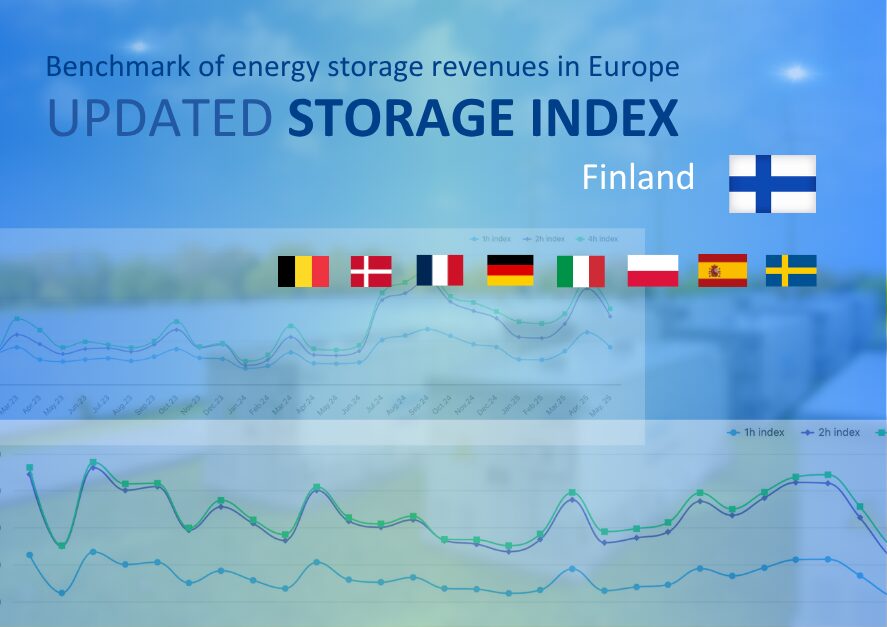 Previous
Previous

 July 15, 2025
July 15, 2025 As part of our ongoing expansion, this month’s Storage Index now includes Finland – reflecting the country’s growing role in Europe’s energy storage landscape.
Below are insights from our experts on the latest market developments across Europe:
In Finland, high profitability in 2023 was driven by attractive capacity reservation prices and market spreads. Recent market reorganizations and increased volatility due to a transition to 15-minute balancing have influenced prices, with some decline in FCR-N reserve prices since April 2025. Despite this, large spreads and volatility in the aFRR energy market have maintained overall revenue levels.
BESS revenues in Belgium continued the upward trend observed in April and May, driven primarily by aFRR prices that tend to spike during days of high renewable output. These spikes may reach up to €150/MW/h for aFRR UP and DOWN reservations. Meanwhile, aFRR activation and imbalance remained stable with spreads around €400/MWh.
aFRR energy prices remained stable throughout June, while capacity reservation prices – particularly for aFRR and FCR -increased overall. Day-Ahead market spreads widened, driven by solar generation, even though the average Day-Ahead price declined. As a result, June was a particularly favorable month for battery profitability in DK1.
In contrast to DK1, average ancillary services reservation prices slightly declined in Eastern Denmark (DK2) in June 2025. However, certain days still saw very high revenues from capacity markets. A modest increase in aFRR energy and Day-Ahead spreads helped offset the downward trend in capacity prices. Overall, battery profitability in DK2 during June was very similar to that observed in May.
In June, BESS revenues in France rose mainly due to higher aFRR Up prices, which are now clearly decoupled from down prices – €25/MW/h for down reservation and €38/MW/h for up reservation. This occurred despite a decrease in aFRR energy spreads, as RTE can now activate lower-cost offers via PICASSO. Additionally, Day-Ahead market spreads increased compared to previous months.
In July, FCR and aFRR UP and DOWN market prices decreased compared to May but remain elevated (averaging around €20/MW/h). The decline in FCR prices had a stronger impact on the total revenues of 1h BESS, whose revenue streams are less diversified. Meanwhile, 2h and 4h BESS systems also benefited from high spreads on the aFRR energy and Day-Ahead markets, maintaining strong revenue levels.
The 2-hour index improved by 46% compared to the previous month. While Day-Ahead and intraday revenues declined sharply, this was more than offset by a nearly 300% increase in MB energy activation revenues and a 65% rise in MSD energy activation revenues.
Record-breaking solar production pushed minimum prices down in the Day-Ahead market, resulting in greater volatility and higher ancillary service prices. Money follows sunlight, and revenues have continued to climb during the summer of 2025 following a cold and gloomy winter.
In June, BESS revenues increased across all durations. This was driven by price and spread increases across all markets and services. aFRR reservation UP prices rose by 81%, while DOWN prices decreased by 32%. When considered symmetrically, aFRR reservation revenues increased by 10% in June. aFRR activation spreads rose by 32%, and balancing spreads by 31%. The most significant growth came from Day-Ahead spreads, which more than tripled in just one month.
There is a 13% improvement in revenue for a 2-hour BESS this month compared to May. This is mostly due to a 34% and 56% increase in the average monthly mFRR UP and mFRR DOWN capacity reservation prices, respectively. FCR-D and FCR-N capacity reservation prices decreased, reducing their contribution to 14% of total revenue (with FCR-D contributing barely 1%). Trading revenue also declined to 9%, making mFRR capacity reservation the primary revenue driver at nearly 80%.
Interested in exploring market opportunities for energy storage?
Contact us to learn more about the Storage Index and our Premium Index offerings.